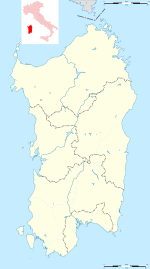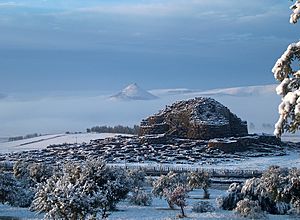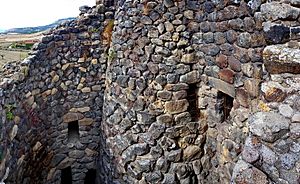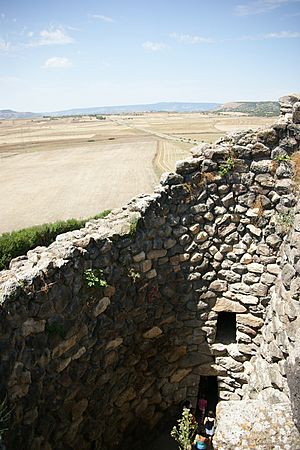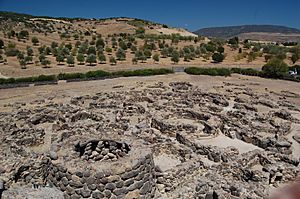Su Nuraxi (Barumini) facts for kids
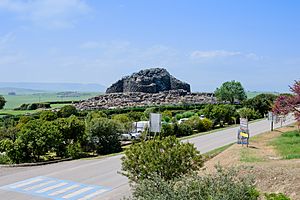
Su Nuraxi in Barumini
|
|
| Location | Barumini, Sardinia, Italy |
|---|---|
| Coordinates | 39°42′21″N 8°59′26″E / 39.70583°N 8.99056°E |
| Type | Settlement |
| History | |
| Founded | 17th century BCE |
| Abandoned | 6th century BCE |
| Periods | Bronze Age |
| Cultures | Nuragic civilization |
| Site notes | |
| Excavation dates | 1950-1957 |
| Archaeologists | Giovanni Lilliu |
| Official name | Su Nuraxi di Barumini |
| Type | Cultural |
| Criteria | i, iii, iv |
| Designated | 1997 (21st session) |
| Reference no. | 833 |
| Region | Europe and North America |
Su Nuraxi is an ancient archaeological site located in Barumini, Sardinia, Italy. The name Su Nuraxi simply means "The Nuraghe" in the local Sardinian language. It is a very old settlement that includes a large stone structure called a Nuraghe and a village that grew up around it.
This amazing site was built by the Nuragic civilization, an ancient culture that lived in Sardinia. Experts believe Su Nuraxi is one of the most impressive examples of their work. Because it's so special, UNESCO added it to their list of World Heritage Sites in 1997. This means it's considered important for everyone in the world to protect.
Contents
What is a Nuraghe?
A Nuraghe is a special type of ancient stone building found only in Sardinia. These buildings were made by the Nuragic people during the Bronze Age. Su Nuraxi is a famous example of a Nuraghe. It was built around the 17th century BCE (about 3,700 years ago!).
How Su Nuraxi Was Built
The oldest part of Su Nuraxi is a tall central tower. It has three rooms stacked on top of each other and stands about 18.6 meters (61 feet) high. This tower was built using large blocks of basalt stone.
Later, during the Late Bronze Age, four more towers were added around the central one. These towers were connected by strong walls, forming a kind of fortress. There was also an inner courtyard with a well inside. Even later, during the Iron Age, another wall with seven rounded sections was built around the whole complex.
What Was the Nuraghe Used For?
People are still discussing what Nuraghes were used for. The archaeologist Giovanni Lilliu, who discovered Su Nuraxi, thought it was mainly a fortress. This means it was used for protection and defense.
Other experts think the oldest part of the Nuraghe might have been used for religious ceremonies or as a meeting place for leaders. The added towers might have been for military purposes or even for storing food.
The Ancient Village
Around the main Nuraghe, a village grew up. This village was home to many people from the Late Bronze Age until about the 6th century BCE. It's hard to know exactly how many huts were there at any one time, but the number changed a lot. It could have been anywhere from 40 to 200 huts, meaning the village might have had 100 to 1,000 people living there.
The huts were usually round and built with large stones and dry stone walls. Their roofs were made of wood and branches, shaped like cones. At first, many huts might have been connected. Over time, people started building separate homes.
Some of the larger, more complex huts were likely used for important meetings of the village leaders. One special hut even had symbols of the gods the people worshipped. Other rooms in the village were used as workshops, kitchens, or places to process food from farming. Around the 9th or 8th century BCE, the village even had a system for wastewater, a paved square, and streets!
The village was damaged and rebuilt several times. It was used by the Carthaginian Empire and later by the Roman Empire. Eventually, the entire site was completely abandoned. Su Nuraxi and its village were connected to other Nuraghes nearby, forming a network of settlements.
Discovering Su Nuraxi
The amazing archaeological site of Su Nuraxi was fully dug up between 1950 and 1957. This work was led by Giovanni Lilliu, an expert from the local area. The excavations helped archaeologists understand how the towers and village were built over many years. They also confirmed that Su Nuraxi was an important and busy place until the 1st century BCE, even during the Roman period.
During the digs, archaeologists found many important items. These included tools, weapons, pottery, and beautiful ornaments. These finds help us learn more about the daily lives of the ancient Nuragic people. There is another important Nuragic site nearby called Casa Zapata, where many interesting finds are displayed in a museum.
Images for kids
See also
 In Spanish: Su Nuraxi para niños
In Spanish: Su Nuraxi para niños


